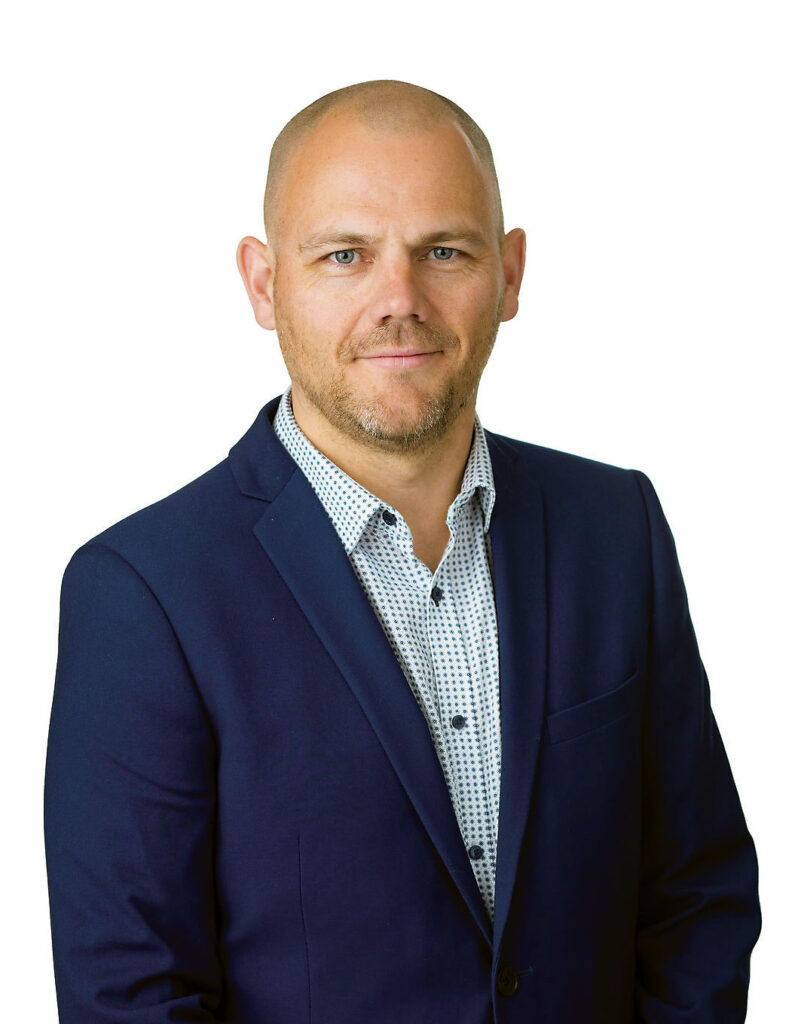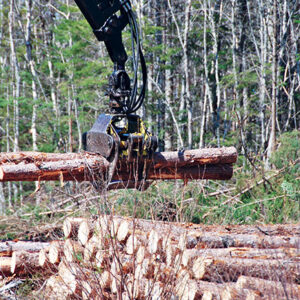
Features
Q&A with Forest Nova Scotia’s Stephen Moore
February 20, 2024 By Maria Church
 Stephen Moore is the executive director of Forest Nova Scotia.
Stephen Moore is the executive director of Forest Nova Scotia. Stephen Moore, one-year-in executive director of Forest Nova Scotia, wants to see the sector at the decision table when it comes to the future of forests in the province.
Moore’s political and polling background is driving some wins for the association, which has a mammoth task of helping the industry navigate a period of transition.
CFI chatted with Moore about his priorities and thoughts on what’s needed to ensure a sustainable forest sector.
CFI: What is your background and what led you to forestry?
Moore: I began working in politics around 2010 and I’ve been engaged in that world in a variety of roles. I worked for [past] Premier Stephen McNeil for a while. I ran a polling company, provided government relations advice, then I ended up here at Forest Nova Scotia.
I’m originally from Glace Bay. That’s a mining and fishing town. Very resource focused, resource based. I saw people in my family really impacted by the closures of the mines and the downturn of fishing operations. I have first-hand, personal experience for what happens when a resource sector doesn’t start to evolve; doesn’t look to the future as effectively as possible. When everything started to shut down, I would have been in high school. You saw what it meant for people without jobs. You saw standards of living change.
Knowing that forestry is going through a tough period in Nova Scotia, it really resonated with me in that way. That was a big reason I got interested. The more I researched the sector in Nova Scotia, I already understood the economic importance, but I came to have a better understanding of the positive environmental impact that forestry can and does have as well.
A lot of what I thought was missing from forestry in Nova Scotia was a political voice, a more positive narrative, and a willingness to push back. When I saw that gap, I thought this position aligned well with what I do. I’m not a forester, I’m very rookie in that space. I frequently refer to myself as a really effective talking head. That’s what I do.
CFI: What has been your experience with the industry and its members since taking on the role of executive director of Forest Nova Scotia?
I just passed my first year this October. I wanted my first year to be listening and acting in a ways around public opinion and ensuring of public support. We did a massive consultation. I would have spoken to over 1,000 Nova Scotians both inside and outside of the sector about forestry. We conducted a lot of market research to find out what people thought.
One thing that I found is that a lot of people who work in forestry didn’t feel they could go down to Tim Hortons and be proud of what they did for a living. And that was eye opening to me. I’m a political staffer by trade so I’m used to not being liked, that’s fine! You get used to that over time. But for someone who works in the woods, who works in forestry, knowing the impact of the sector, for them to not feel proud about what they do for a living I thought was really heavy for people.
When we did the public opinion research, we found over 70 per cent of people approved of our sector. Over 70 per cent of people thought that we were environmentally responsible. That is positive. We started sharing that with our members and with politicians of all stripes.
One of my theories coming into it when I was interviewing for this job is that the loud voices weren’t representative of the broader views – and it’s true. You have a few groups who have been very effective at capturing the media, but don’t represent the views of the vast majority of Nova Scotians. That was an early sign that we have more leeway to do what we thought we needed to do.
I think one of the things that forestry has lacked is political muscle and we’re slowing growing that. Part of what we’ve been working on over the last year is more effective engagement with decisionmakers, provincially and federally. We’ve had some success, pushing back on problematic herbicide spraying rules for the sector. We mobilized hundreds of letters sent in 24 hours and we achieved that policy change. We submitted our proposal to the province’s protected areas strategy, and it’s been very well received. We’re expecting to see more things come out over the next 12 months.
The year has been quite busy, but it’s been about building up support and trying to push our positive narrative, push solutions, but also push back against a lot of the false narratives that exist.
CFI: How do you view the shift in Nova Scotia’s forest industry over the past few years following some pretty significant changes?
In the last five years, with the Northern Pulp situation, we’ve seen the number of buyers for wood products in Nova Scotia decline 20 per cent. We’ve seen the contractor capacity in the province reduce by 40 per cent. Those are pointing to a lot of very serious issues. Northern Pulp purchases well over one million tons of low-grade fibre every year. That is one massive economic hit to sector, not just the jobs at the mill by the effects for the sawmills, the woodlots and the contractors. That’s a very serious challenge.
When we talk about challenges, there are couple closely related to that: the decline in contractors, and of the workforce and the challenge of capital. But there are things that can be done, and these are the things we are talking to the province about as well.
The Lahey Report has added to the uncertainty. We as an organization endorse the report. The Lahey Report is a really delicate balance – you need all aspects of it that were agreed upon in order to ensure both economic and environmental sustainability. You need both of those. My biggest concern is that we’ll see the report selectively implemented.
There has been a tremendous focus on conservation and that’s fine up to a point. But too much conservation isn’t good either – less provincial revenues, less effective carbon capturing in the forest, and increased wildfire risk. I think Nova Scotians are starting to understand that.
One of the more frustrating things is that the Lahey Report came out and said concerns around herbicide use are not based on science, and yet we still have to fight this all of the time. The report even said the province should fund the use of herbicide on Crown land, which they have decided not to do.
CFI: What’s your take on the forest industry’s so-called social license in Nova Scotia?
Anybody who has heard me speak in a room knows how grumpy I get when we say we need to work to get social license. I’ve been involved in polling now for almost 20 years. If you have seven out of 10 people agreeing on something, that is rare. I don’t know exactly what social license looks like, but I know seven out of 10 is as close you are going to get. We spend too much time trying to achieve consensus and appeasement. I don’t think they create good strategy for anybody. There are some groups that are never going to be happy so long as we’re cutting a single tree. There are groups that fundraise to stop us from existing. The idea that we are going to win them over is silly.
But we come back to what the facts are: we take more carbon out of the environment than we put into it. We create essential products that are addressing some of the biggest problems: from building homes to combating energy poverty. Those things need to happen, but some people don’t want to see it happening where they go for hikes.
This past year, we launched the Our Trees campaign and that was by far the largest advertising campaign in Forest Nova Scotia’s history – in forestry’s history potentially in Atlantic Canada. It was substantial. We reached 75 per cent of Nova Scotians. We were on television, we were on podcasts, we used Instagram influencers. We ran digital ads, billboards, print. Basically, if there was a spot in the province, we were able to advertise we were there.
We also gave away 16,000 seedlings that families could plant. We were trying to get people connected to what it is our members are doing every day. I like the idea that, in 10 years, you can look out your window and see the seedling that you planted with your kids and remember that you got it from that weird forestry group at the local farmers market. Through this campaign, we grew our list of supporters more than tenfold. It numbers almost 10,000. We anticipate that to keep growing.
I say we have social license. We need to stop worrying about playing nice with everybody. We need to focus instead on what we need to do to move the sector forward. We’re trending in the right direction.
CFI: What gets you up in the morning in your new role as a leader in the forest sector?
I love the work, to be honest with you. People are built to do certain things and I’m built to be a political animal. But that’s not what gets me up.
The more folks I get to meet in the sector, the more I feel like I’m around and kitchen at my grandparents’ place. These are good, hardworking folks who just want to get up, day in and day out, to do good job, help their families, and help their communities. But they need to have a voice. I want to make sure that they have an effective voice. With my skill set, that’s the best way I can help. I want them to be proud of what they do.
Print this page

